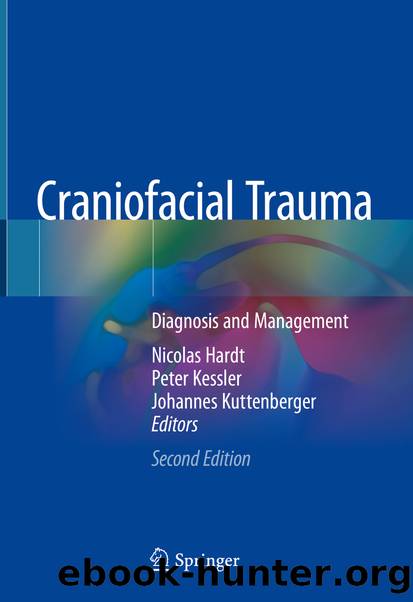Craniofacial Trauma by Unknown

Author:Unknown
Language: eng
Format: epub
ISBN: 9783319772103
Publisher: Springer International Publishing
8.4.3 Advantages, Disadvantages, and Risks Associated with the Transcranial Approach
Without doubt the extradural and intradural approaches pose a greater operative risk than the subcranial approach, particularly when early surgery is undertaken. The danger of postoperative cerebral edema is far greater in recent cerebral injuries (Probst and Tomaschett 1990).
With approximately 3% there is a much lower mortality rate after the edema has subsided and the cerebral parameters have normalized (Loew et al. 1984).
Postponed intracranial intervention in the treatment of dural and skull base lesions, awaiting the subsidence of the cerebral edema, consequently results in a postponed primary surgical treatment of the midfacial fractures and the skull base by 2–3 weeks. As a result of delayed surgery and beginning fracture consolidation, bone reduction is complicated and hence may entail secondary surgery at a later date.
Furthermore, an increased risk of ascending infection exists from deferred surgery owing to congestion and secretion in the paranasal sinuses as well as an increased risk of meningitis resulting from the untreated skull base fractures (Vuillemin et al. 1988).
A partial or total anosmia is not always avoidable. This may either be a consequence of trauma, particularly from dislocated fragments in the medial skull base region, or it may result from surgical exploration, especially if the olfactory fibers have to be transected bilaterally (Samii 1989).
Olfactory dysfunction (hyp- or anosmia) as a result of the surgical transcranial intervention was found in 7–8% (Neidhardt 2002; Schroth et al. 2004).
Other disadvantages may arise from the comparatively large wound surface and technically from the problematic treatment of the olfactory groove, concerning preservation of olfactory function, the direct contact with the cerebral cortex, pontine veins, and the superior sagittal sinus (Füssler et al. 1996; Rosahl et al. 1996; Lehmann et al. 1998).
The narrow access to the sphenoidal sinus and further dural tears as a consequence of surgery in areas where it is particularly adherent (medial ethmoidal roof, cribriform plate, crista galli) pose additional risks (Lehmann et al. 1998).
With a supplementary frontofacial osteotomy, the frontal base can be tangentially exposed, bone fragments removed, and the skull base reconstructed without excessive retraction of the cerebral structures. The surgical trauma is minimized and at the same time a radical ethmoidectomy—as in the subcranial approach—can be avoided (Kuttenberger and Hardt 2001).
Download
This site does not store any files on its server. We only index and link to content provided by other sites. Please contact the content providers to delete copyright contents if any and email us, we'll remove relevant links or contents immediately.
Should I Stay or Should I Go? by Ramani Durvasula(7570)
Why We Sleep: Unlocking the Power of Sleep and Dreams by Matthew Walker(6620)
Fear by Osho(4662)
Flow by Mihaly Csikszentmihalyi(4639)
Rising Strong by Brene Brown(4380)
Why We Sleep by Matthew Walker(4362)
The Hacking of the American Mind by Robert H. Lustig(4319)
How to Change Your Mind by Michael Pollan(4292)
Too Much and Not the Mood by Durga Chew-Bose(4278)
Lost Connections by Johann Hari(4098)
He's Just Not That Into You by Greg Behrendt & Liz Tuccillo(3834)
Evolve Your Brain by Joe Dispenza(3615)
The Courage to Be Disliked by Ichiro Kishimi & Fumitake Koga(3419)
Crazy Is My Superpower by A.J. Mendez Brooks(3332)
In Cold Blood by Truman Capote(3311)
Resisting Happiness by Matthew Kelly(3303)
What If This Were Enough? by Heather Havrilesky(3275)
The Book of Human Emotions by Tiffany Watt Smith(3238)
Descartes' Error by Antonio Damasio(3232)
